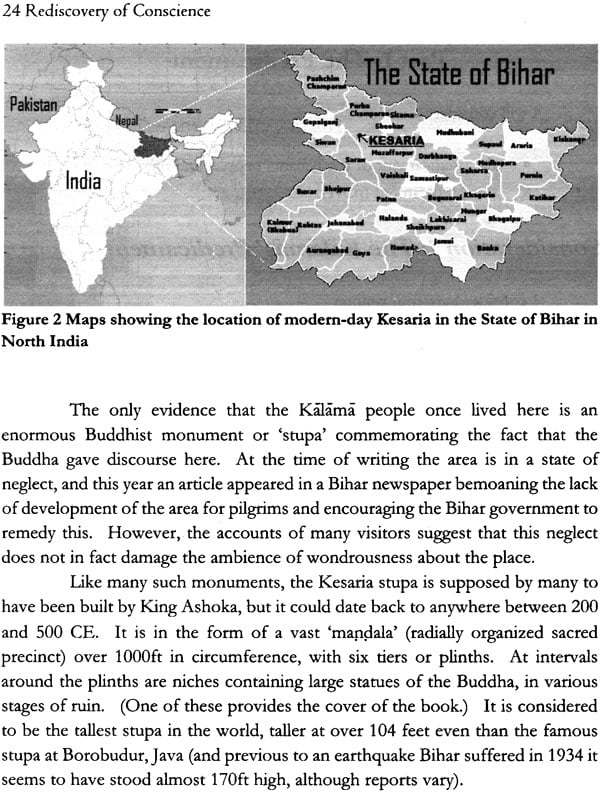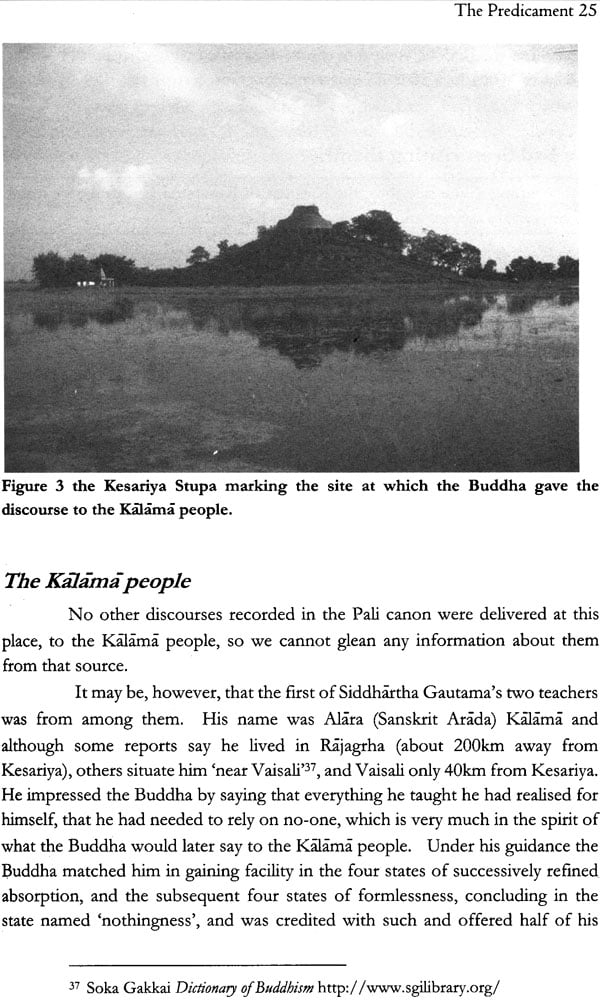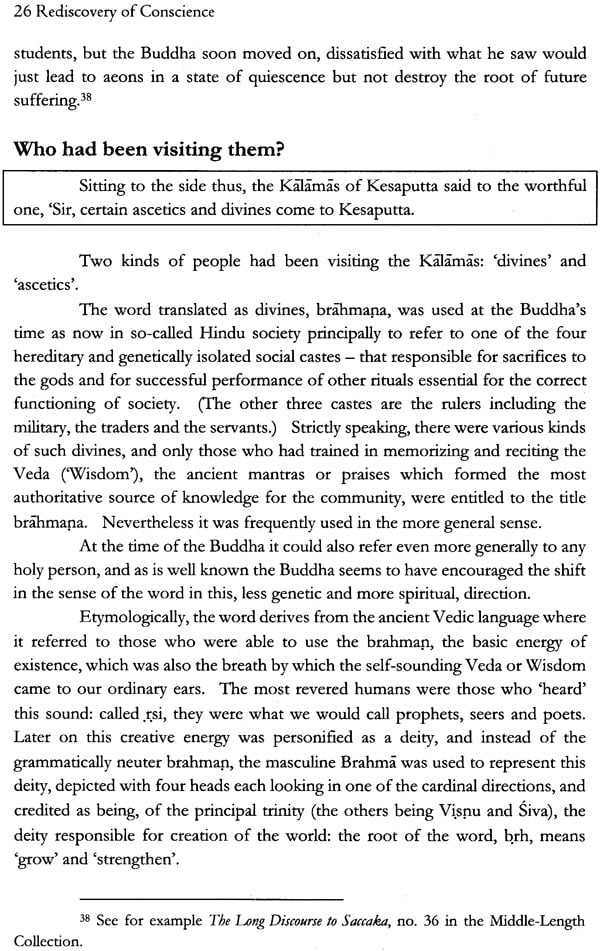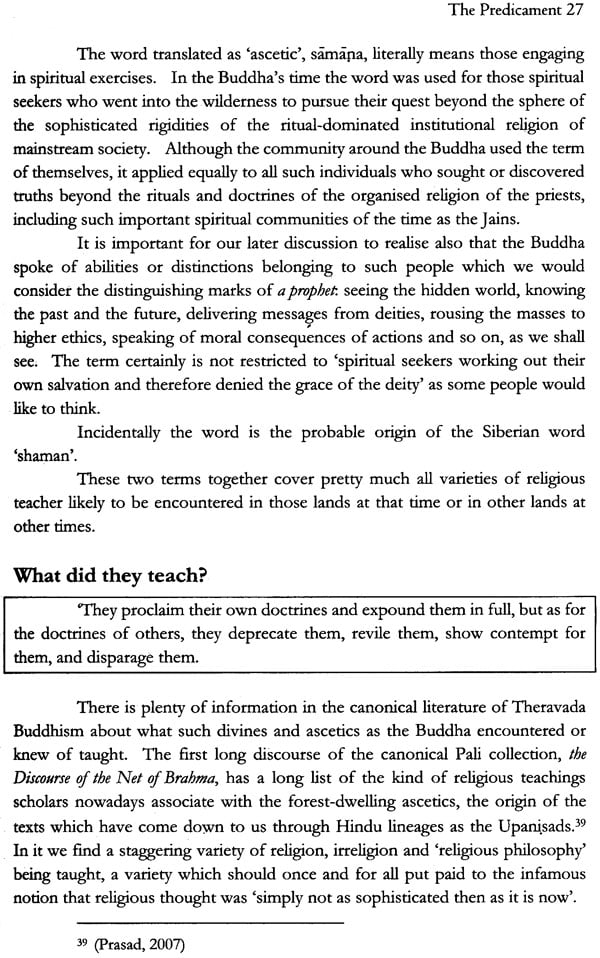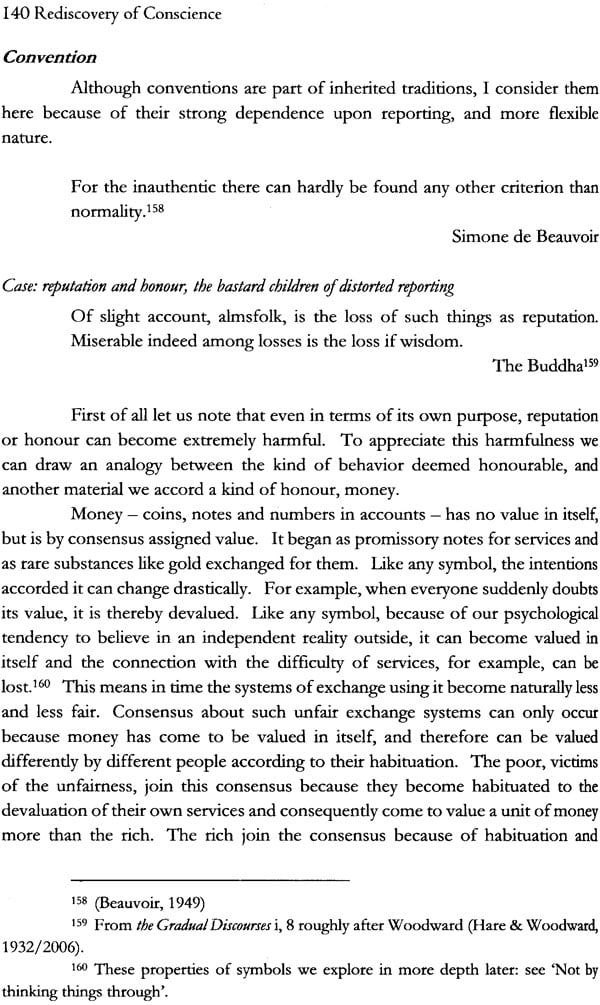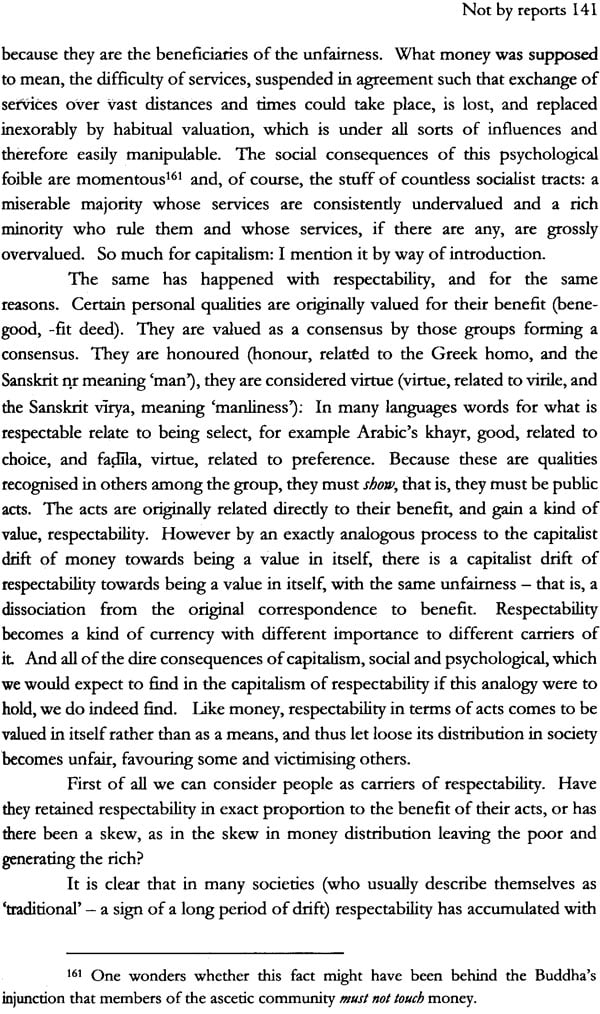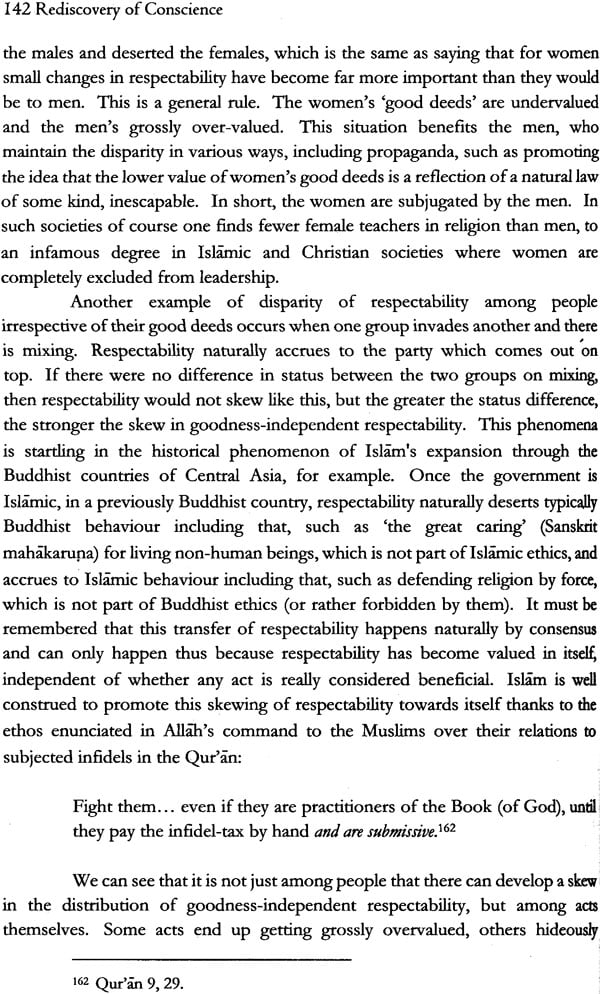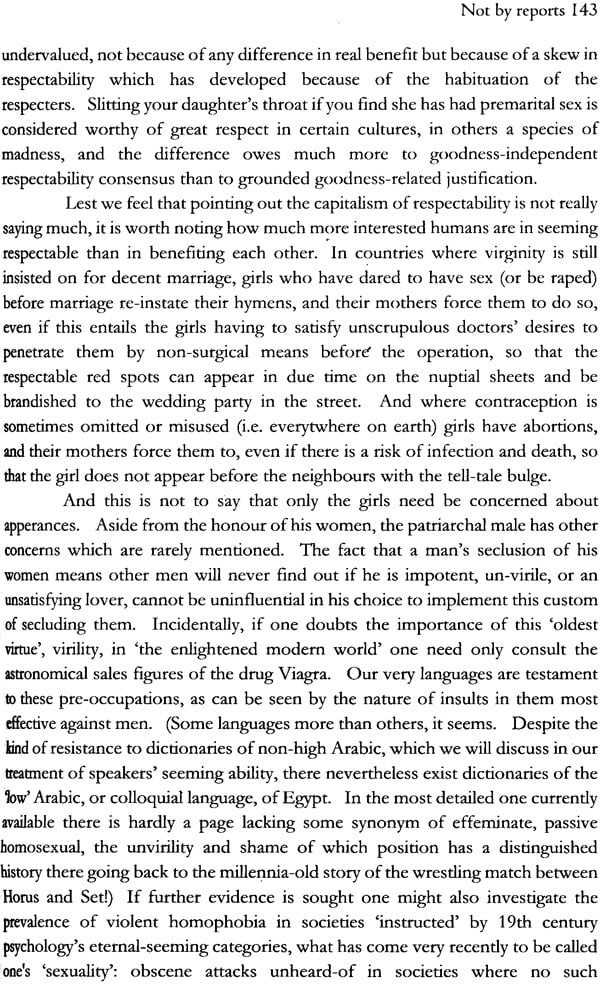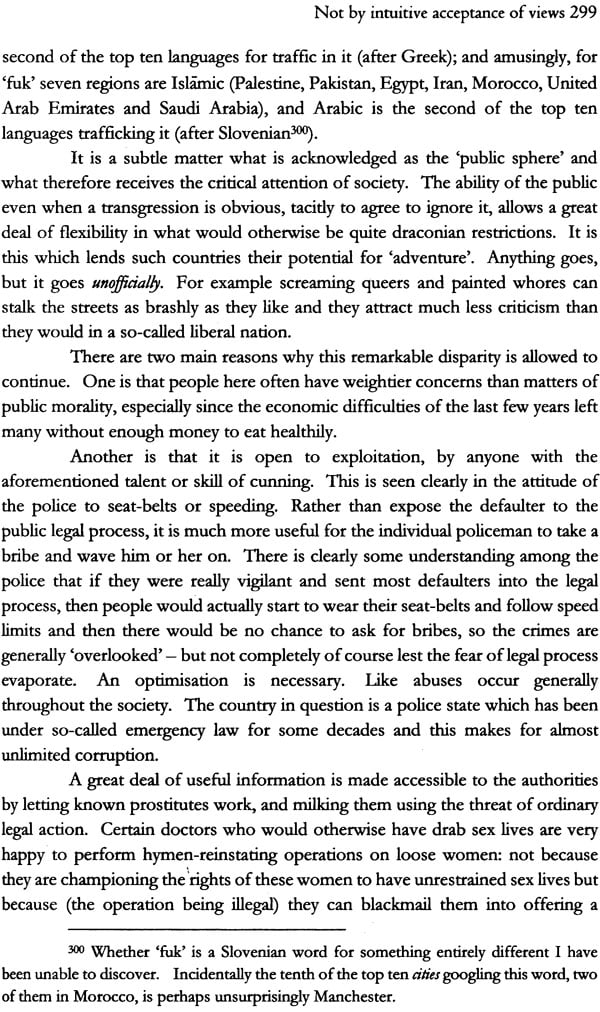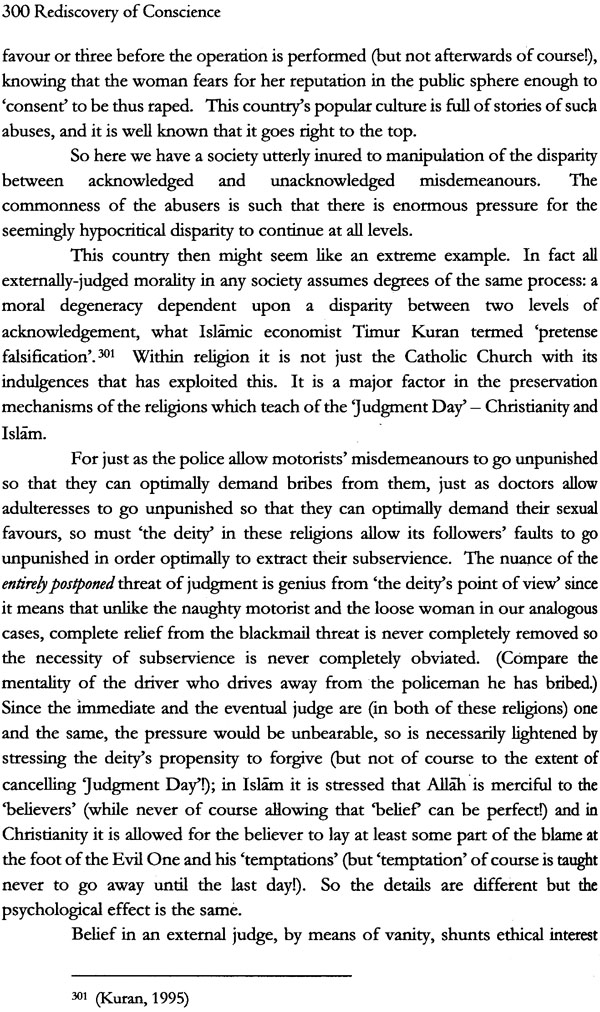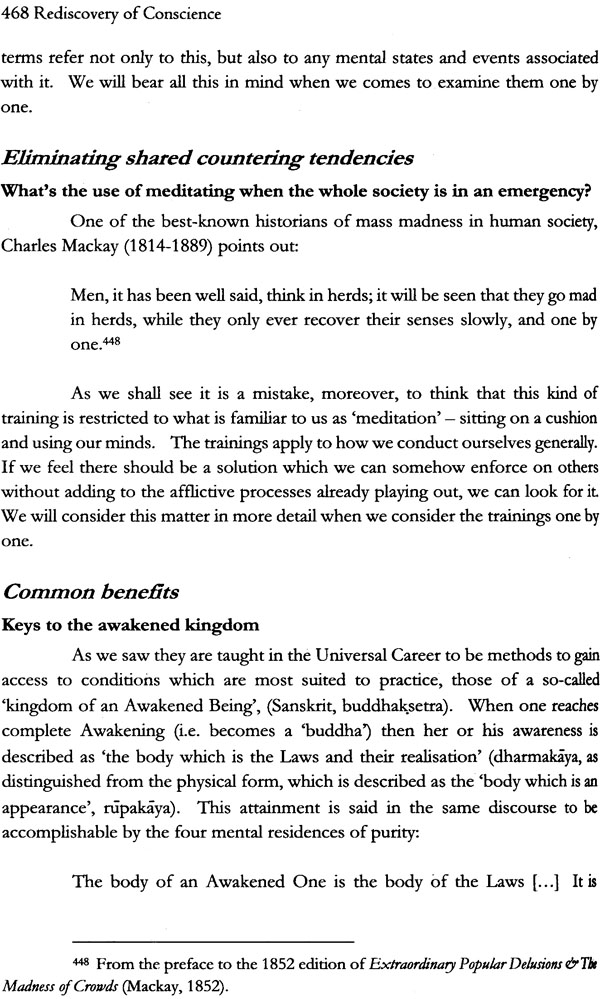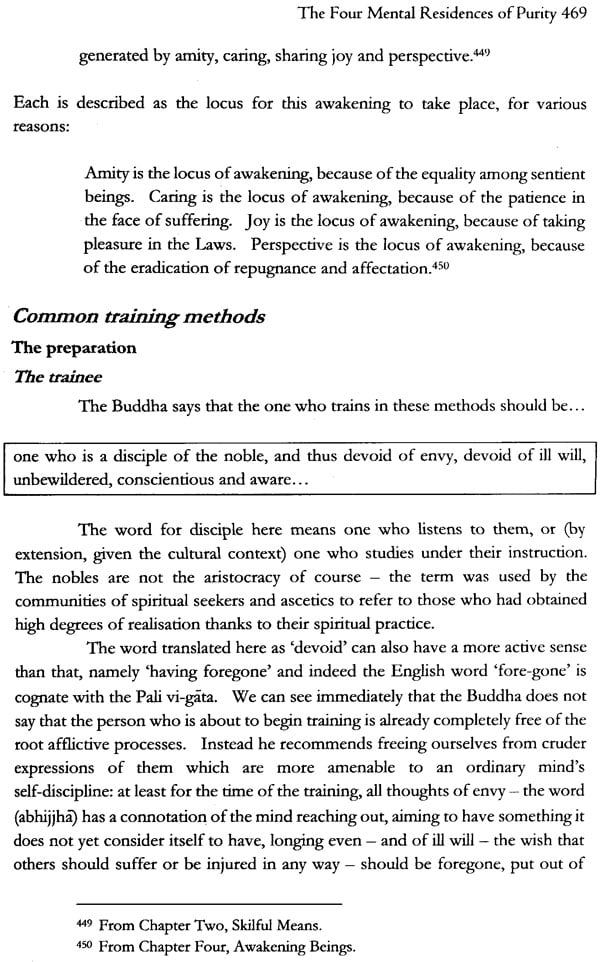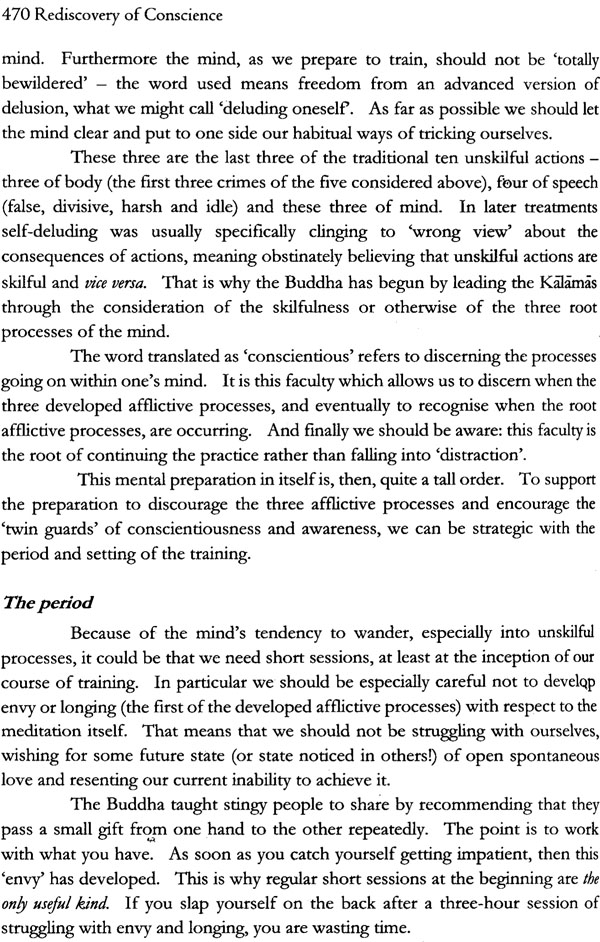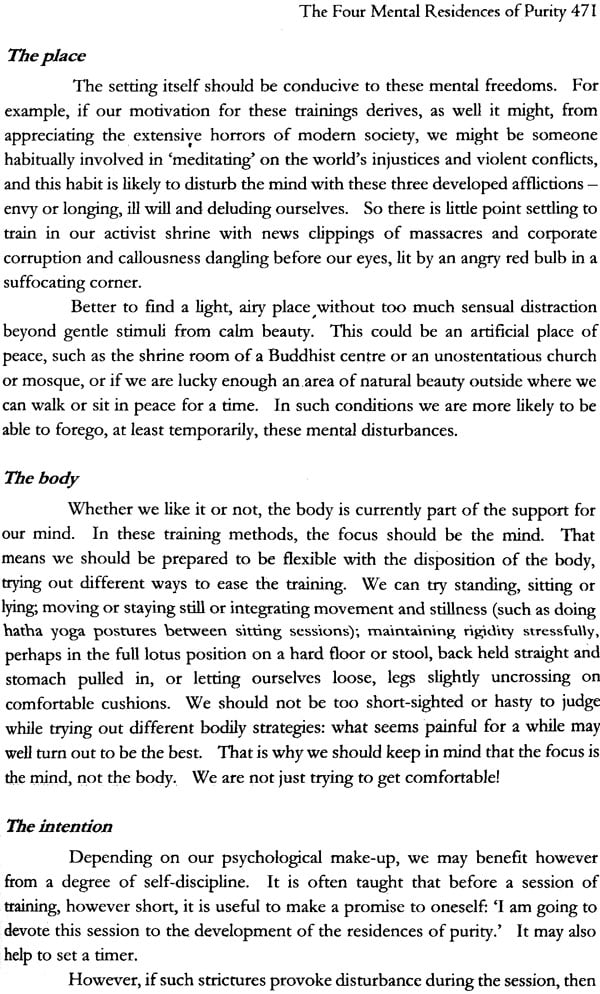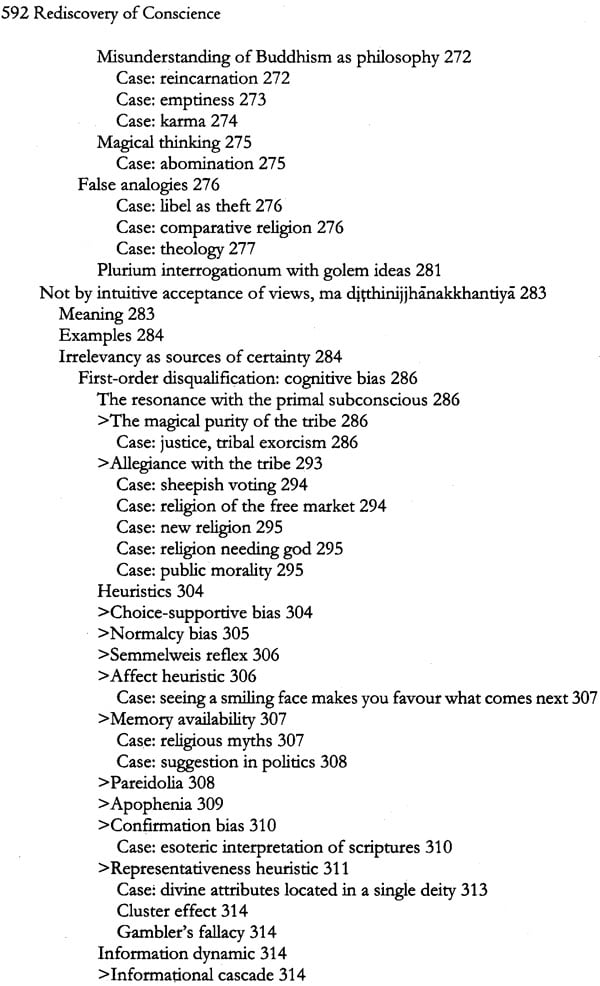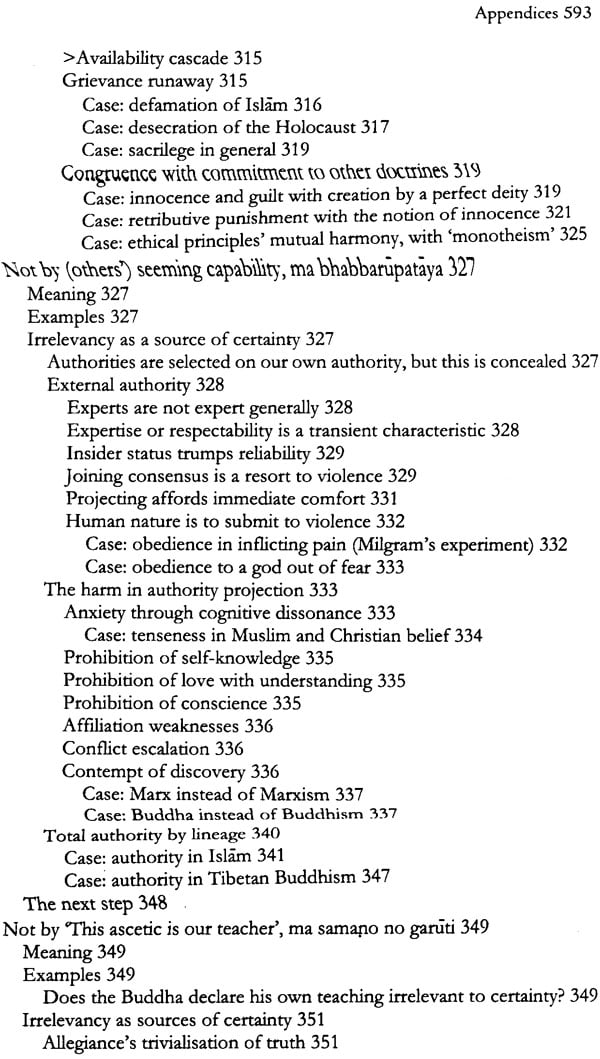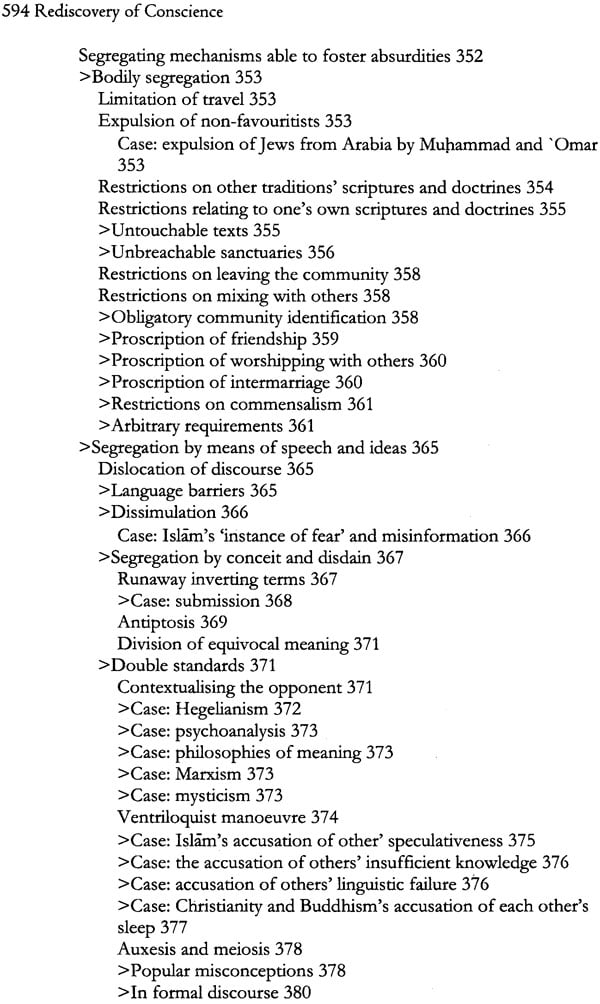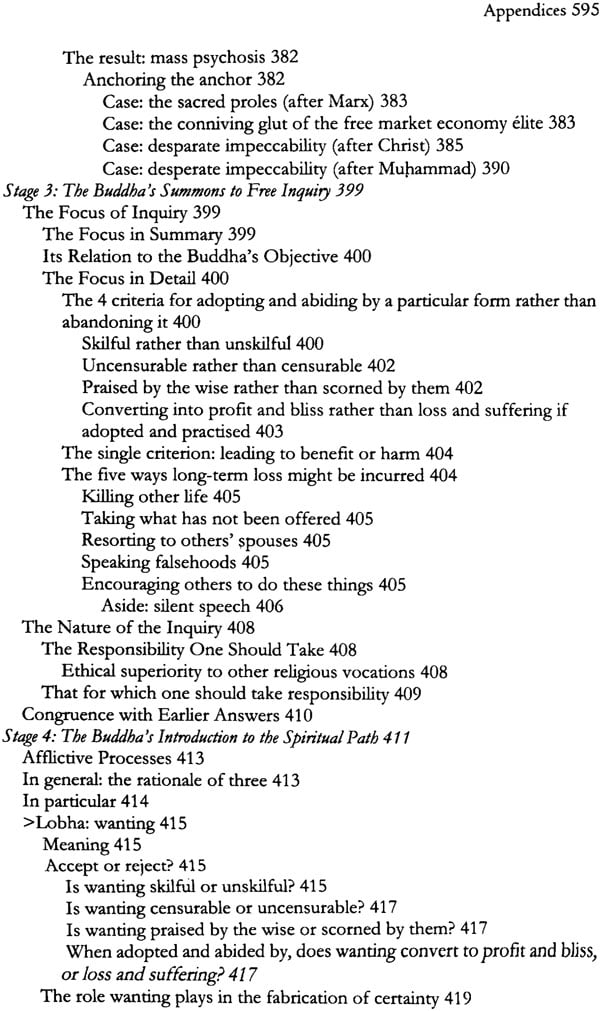
Kalama Sutta (The Rediscovery of Conscience)
Book Specification
| Item Code: | NAM357 |
| Author: | Saber Uddiyan |
| Publisher: | Vajra Books, Nepal |
| Language: | English |
| Edition: | 2010 |
| ISBN: | 9789937506502 |
| Pages: | 616 (6 B/W Illustrations) |
| Cover: | Paperback |
| Other Details | 8.5 inch x 5.5 inch |
| Weight | 570 gm |
Book Description
With these words, among his most famous, the Buddha threw down a gauntlet for authentic seekers of truth and well-being that we in modern times rarely have the courage to take up. In our global village embittered by conflict and manipulated for profit, we cling more to identities and care for each other less than ever. It is hard to imagine a time when we have needed this advice from the Buddha more than we do now.
Including a new, authoritative translation of the entire Kalama Sutta, and the original Pali for reciting, this detailed and wide-ranging commentary relates modern individual and social problems to the Buddha's inquiry, and includes trenchant re-appraisal of Christianity and Islam, as well as modern ideologies such as free market capitalism, security mania and grievance culture. It presents detailed practical instructions on how to apply the powerful methods the Buddha suggests to rediscover the conscience which can guide us on an authentic and liberating path.
The author did his undergraduate degree and doctoral research in evolutionary biology at Cambridge University then pursued training in the traditional Tibetan Buddhist philosophical college at the Rangiung Yeshe Institute in Nepal together with tantric training under various Buddhist and Bon teachers. He lives in Egypt, and is a member of the Burhaniyya Sufi order.
Here we present two books:
Book One is the original Pali text and a new English translation of the Kalama Sutta. I have taken as authoritative the Pali text from the Chattha Sangayana (the Sixth Council of the Elders' School, which took place at Kaba Aye, in Yangon, Myanmar in 1954) as avaliable at the website" of the Vipassana Research Institute at Igatpuri, India, which includes variant readings. I have compared previous complete translations by F. L. Woodward, Thannisaro Bhikkhu, Soma Thera and partial translations by Hari Shankar Prasad and Saya U Chit Tin, Translation rationales are given in an appendix.
Book Two is my detailed commentary on, and reflection on the implications of, the discourse. Its main purpose is to,demonstrate the urgent relevance of the discourse to our situation in the world today. It will be noted that I have taken the scope of the Buddha's advice to be very broad. Such an approach has been criticised by some members of the Elders' School. However, I believe that I have sufficiently justified this choice of scope in the course of the commentary.
A few of the points made are original, most not. Some of the latter are expressed in what will seem novel ways. This is partly because of my lack of familiarity with many of the disciplines the Buddha's advice touches on, but also partly out of a sense that not only need one not frame points in particular jargon, but also those wisdoms in danger of neglect deserve expressing again and again in fresh language.
While I have aimed for even-handedness and meticulousness, there is behind the points I attemt to elucidate what the Buddha would probably disparage as 'sarambha', which means getting into a temper and becoming haughty, a term applied especially in a situation of mutual grappling. It is my regretful conviction that, original or not, these are all points which should be remembered again and again if we are to remain sane on this earth. The commentary is presented therefore with something of a sense of urgency which I do not claim always to have repressed.
I have drawn on my little knowledge of Buddhist, Islamic and Christian teachings, which I owe entirely to my teachers, and for any distortions of which, unwittingly wrought due to the limitations of my understanding, I apologise. Because the commentary is so far-ranging it touches on a great number of academic fields in which I have insufficient experience to contextualise my points or frame them in language workers in those fields would find familiar. I beg their patience in this matter and hope I have not trodden on too many toes.
The commentary will, I hope, be found insightful, no matter from what background the reader comes. It is most emphatically not intended for Buddhists alone: the points apply to a diversity of practices and beliefs. A great deal of discussion of Islam and Christianity is made, for example, and I hope adherents of those faiths will read it carefully and seriously, for although challenges are made to elements in those faiths (as to elements in Buddhism) they are made carefully and seriously. But its most urgent message addresses not these religions' doctrines but certain seldom questioned characteristics found among them and their adherents and more importantly beyond them, in secular society as much as in the religious, characteristics which drag us all towards catastrophe and require remedial measures.
The Kalama: Sutta, whether or not it stands as the vindication of free inquiry the rationalist enthusiasts would like it to be, presents, I am quite persuaded, a trenchant critique of these ominous characteristics, and offers radical and surprising solutions to them.
I hope and pray that, through the circumstance of her or his intelligence, meeting the discourse and considering, with the aid of the commentary, its implications, the reader will feel encouraged and empowered to contribute to realising these solutions.
The Kalama Sutta: a minor scripture of Theravada Buddhism?
The scriptures known as the 'Pali canon' ('Pali' referring to the language of these scriptures, and meaning 'scriptural,) of the Theravada or 'Elders' School' of Buddhism were first published in their entirety in Burma in 1900 CE and the oldest surviving manuscripts are (incomplete and) from the 15th century. However the school's tradition maintains that the scriptures have been copied in writing continuously since the 1st century BCE and between the Buddha's lifetime and then that they were transmitted perfectly orally.
Among them the Kalama Sutta does not stand out as being particularly important, at least if we judge by how it has been classified. Fig. 1 shows the Pali canon's divisions. Within the 'Three Boxes' or Tipitaka it is in the Discourse Box, the Sutta Pitaka, meaning that it is a record of a discourse given by the Buddha or one of the major disciples (in this case by the Buddha) on the Laws of Reality, Dhamma, rather than regulations of monastic discipline, Vinaya, or the classified 'Higher Teaching', Abhidhamma. Among the Discourses it is classified as one of the Numerical Section, the Anguttara Nikaya, because it was felt that some numbered list of phenomena in it was its most defining feature. Among these it is placed in the Threes Section, Tika Nipata, since in this case it is a list of three phenomena which is included in the discourse. Among these it is placed in the fifth or Minor Group, Culavagga, and within that, in the second or Large Group, Mahavagga. Within that it is the fifth discourse.
Most scholars concur on the unlikelihood of these texts recording what the Buddha said, though the texts themselves make that claim, but also on the probability that a lot of what the Buddha did teach is likely to be in the texts somewhere, though with a lot of later material added, and with a great many adjustments for the sake of memorising the texts for oral transmission: they contain a great deal of formalised chunks which are repeated pretty much unchanged throughout the texts, and this discourse includes several. Much of the material in this discourse is repeated verbatim in the next one, delivered not by the Buddha but by the disciple Nandaka, to Salha, and in another discourse to the Licchavi Bhaddiya.
However many people today who have never practised Buddhism in any tradition, and who certainly are not Pali scholars delving into the further nooks and crannies of the Three Baskets, have heard of the Kalama Sutta. It has gained a certain notoriety, and as we shall see this is not by accident, for its contents speak to us directly across the millennia, and seem if anything more relevant today than they were when first delivered.
The Kalama Sutta: The Buddha's Charter of Free Inquiry?
In stark contrast to this lowly status in the canon, was the exalting appreciation of the discourse which quickly developed in post-Christian countries, by which I mean those countries which, in the last century or so, have seen an explosion of interest in religion or 'spiritual approaches' other that the Christianity which had previously dominated them. In these countries science had become the new authority, and religious faith a private, and for some even embarrassing; matter.
For them the novelty of Buddhism as it was being 'discovered' (in the same sense, if sense is the word, as America had been) was exciting. Here was a religion which needed no Creator God, but emphasised the spiritual path as something to be worked out by the individual. Its frequent insistence on direct experience and its deconstruction or even disregard of metaphysics had an obvious resonance with the scientific method that excessively metaphysical Christianity conspicuously lacked. Schopenhauer and others were convinced that this new contact (with Buddhism and Hinduism) would lead to a much-needed revolution in European thought. Since then a great deal has been written on the parallels between Buddhism and science, Buddhism or Hinduism or Taoism and quantum physics, Buddhism and psychoanalysis, etc. And the Kalama Sutta has become perhaps the most quoted scripture in Buddhism.
However, as they suffered from afar this extraordinary spectacle, some doctors in its 'more native' lands were not amused, as is exemplified by various articles they wrote in which they showed themselves highly critical of it.
There is at present a view, widely prevalent especially among the educated Buddhists, that Buddhism is a rationalist teaching based on scientifically verifiable evidence. Much has been written to substantiate this view-point and, undoubtedly, such writings have immensely contributed to the further strengthening and spreading of this view. Most of the proponents of this view cite the Kalama Sutta of the Anguttara-nikaya as providing unassailable evidence to prove that Buddhism is a rationalistic teaching with an absolutely scientific basis, and that the Buddha advocated a rationalistic approach as the sole method of understanding all his teachings.
It is no exaggeration to say that it is Western scholarship that highlighted the importance of the Kalama Sutta as some kind of 'Charter of Free Inquiry'. This 'new finding' was enthusiastically taken up and strongly supported by the predominantly Western-trained Buddhist scholarship of the time to bring to light that the Buddha denounced adherence to blind faith and dogmatism and instead encouraged free inquiry and investigation. In further support of such a position, these writers cited the Buddha's rejection of the belief in a divine creator, his acceptance of free will, his anthropocentric approach to the human predicament, his acceptance of the superiority of man, his invitation to the followers to inquire about the Dhamma as well as his own claim to enlightenment and so on.
There was lively concern that the Buddha was being misrepresented:
On the basis of a single passage, quoted out of context, the Buddha has been made out to be a pragmatic empiricist who dismisses all doctrine and faith, and whose Dhamma is simply a freethinker's kit to truth which invites each one to accept and reject whatever he [sic] likes. But does the Kalama Sutta really justify such views? Or do we meet in these claims just another set of variations on that egregious old tendency to interpret the Dhamma according to whatever notions are congenial to oneself - or to those to whom one is preaching? [ ... ] Partly in reaction to dogmatic religion, partly in subservience to the reigning paradigm of objective scientific knowledge, it has become fashionable to hold, by appeal to the Kalama Sutta, that the Buddha's teaching dispenses with faith and formulated doctrine and asks us to accept only what we can personally verify,"?
The discourse passage in question, so often quoted, 'out of context', is a list of widely accepted sources of knowledge or authorities, each of which the Buddha advises should not be relied on for certainty in the matter of deciding what practices to adopt and what practices to abandon. The new converts, carried away by their rationalist enthusiasm (as it were), were perceived to have extended the scope of the Buddha's advice too far.
…they concluded that the Kalama Sutta advocates the use of free, independent thinking as the only valid means of deciding what is right and wrong with regard to all matters, religious as well as otherwise. [ ... ] The Sutta itself does not provide any justification to expand the ambit of its application, either to cover all matters pertaining to the Dhamma, or in general to all matters. This second assumption is obviously very far-fetched.
There are many matters that we all cannot understand and know for ourselves. Yet, we accept them and take them for granted reposing 'faith' on the competence of those who pronounce views on them. We would not be able to conduct even affairs of day to day life if we ourselves try to understand and know all issues and problems that we have to face. This is why we seek the help, and advice of those who are more knowledgeable, and possessing expertise in different areas.
Even the first assumption is questionable. The Buddha made this admonition to an ordinary set of people. Therefore, it is apparent that he did not expect them to use any expertise or super-knowledge in deciding on the issues concerned.
In other words, the scope of the advice should be recognised: as to the Kalama people and those like them, asking the same questions they were asking. If it were advocating free inquiry at all, it would be into an ordinary person's confusion at the beginning of the spiritual training only, and not beyond.
However, as we shall see, the Kalama people were not the only people to be advised with this critique of sources of knowledge, and it is debatable how easily we, even dressed in robes, can escape the epithet 'mere ordinary people'. The pronouncements of the elders have not been unanimous:
The Buddha's Charter of Free Inquiry' [ ... ] The instruction of the Kalamas (Kalama Sutta) is justly famous for its encouragement of free inquiry; the spirit of the sutta signifies a teaching that is exempt from fanaticism, bigotry, dogmatism, and intolerance.
The reasonableness of the Dhamma, the Buddha's teaching, is chiefly evident in its welcoming careful examination at all stages of the path to enlightenment.
| Homages | i | Preface | ix | Introduction | xi | Book One: the Kalama Sutta | 1 | Chapter One: The Setting | 3 | Chapter Two: The Predicament | 4 | Chapter Three: The Main Point | 5 | Chapter Four: The Ten Irrelevancies & the criterion for Rejection | 6 | Chapter Five: What to Reject | 7 | Chapter Six: The Ten Irrelevancies & the criterion for Acceptance | 10 | Chapter Seven: What to Accept | 11 | Chapter Eight: The Meditation | 14 | Chapter Nine: The Benefits | 16 | Chapter Ten: The Response of the People | 19 | Book Two: Rediscovery of Conscience, Kalama Sutta Vyakhya | 21 | Part I: The Predicament | 23 | Consideration 1: The Kalamas' Predicament | 23 | Who were the Kalama people? | 23 | Who had been visiting them? | 26 | What did they teach? | 27 | The nature of the Kalamas' consequent difficulties | 40 | Consideration 2: Our Predicament | 41 | The Similarities between the Kalamas' predicament and ours | 41 | What distinguishes us from them | 45 | The implications for our understanding of the discourse | 52 | Part II: The Buddha's Solution | 55 | Stage 1: The Profound Main Point | 57 | The Peculiarities of the Buddha's Answer | 57 | Showing the Relation of the Peculiarities to the Nature of Reality | 58 | Stage 2: The Buddha's Condemnations of Certainty | 69 | General Characteristics | 71 | Detailed Presentation | 87 | Not by faith | 89 | Not by relishing | 95 | Not by recited tradition, ma anussavena | 103 | Not by traditions, ma paramparaya | 110 | Not by reports, ma itikiraya | 129 | Not by what scriptures impart, ma pitakasampadanena | 149 | Not by reason of philosophy, ma takkahetu | 159 | Not by reason of logic, ma nayahetu | 185 | Not by thinking ideas through, ma akaraparivitakkena | 219 | Not by intuitive acceptance of views, ma ditthinijjhanakkhantiya | 283 | Not by (others') seeming capability, ma bhabbarupataya | 327 | Not by 'This ascetic is our teacher', ma samano no garuti | 349 | Stage 3: The Buddha's Summons to Free Inquiry | 399 | The Focus of Inquiry | 399 | The Nature of the Inquiry | 408 | Congruence with Earlier Answers | 410 | Stage 4: The Buddha's Introduction to the Spiritual Path | 411 | Afflictive Processes | 413 | In general: the rationale of three | 413 | In particular | 414 | >Lobha: wanting | 415 | >Dosa: aversion | 425 | >Moha: being deluded | 433 | The Consequences | 443 | >Sarambha: rage | 443 | >Five ways of Ioss | 444 | Freedom from Afflictive Processes | 451 | >Alobha: freedom from wanting | 453 | >Adosa: freedom from aversion | 459 | >Amoha: freedom from delusion | 463 | The Four Mental Residences of Purity | 465 | In common | 467 | In particular | 477 | >Amity (metta) | 479 | >Caring (karuna) | 503 | >Joy (mudita) | 517 | >Perspective (upekkha) | 531 | Stage 5: The Buddha's Vindication of the Inquiry | 545 | Main point: that everything is covered | 545 | Implication: that ideology wastes time | 546 | Specific examples: the afterlife, and ethical consequences | 548 | Part III: The Response from the People | 557 | The response of the audience | 557 | The Buddha's response | 558 | Our response | 562 | Appendix One: Transliteration Schemes | 565 | Pali and Sanskrit | 565 | Arabic | 565 | Appendix Two: Translation rationales | 567 | Bibliography | 573 | Colophon | 583 |
